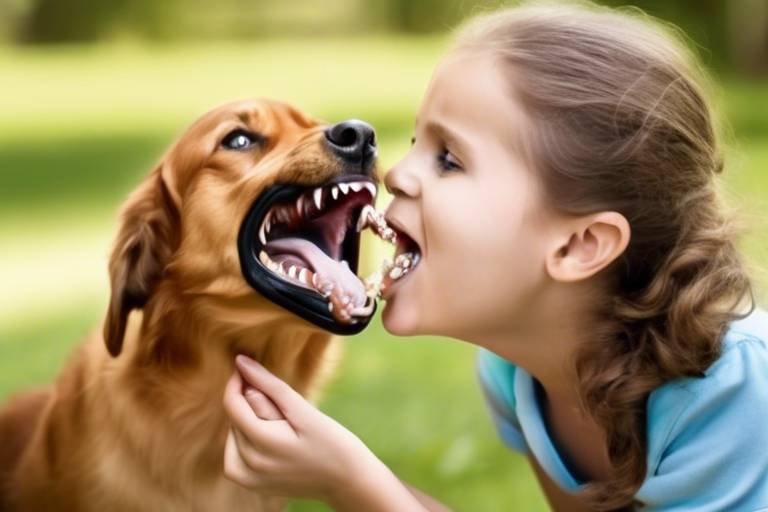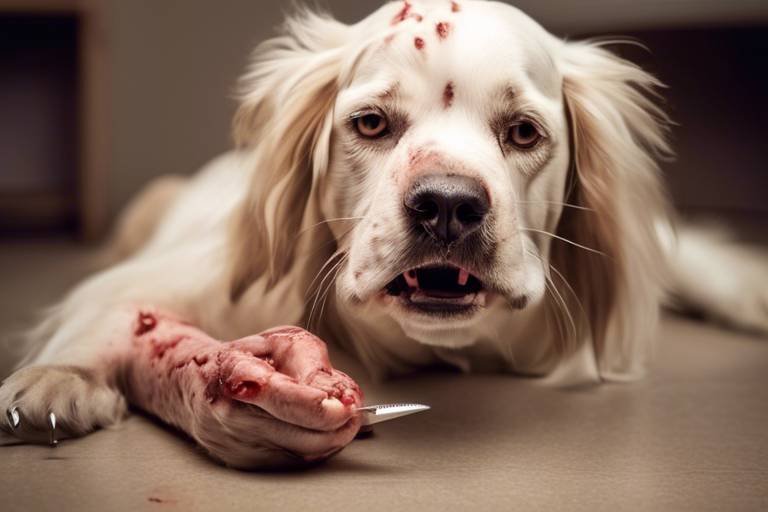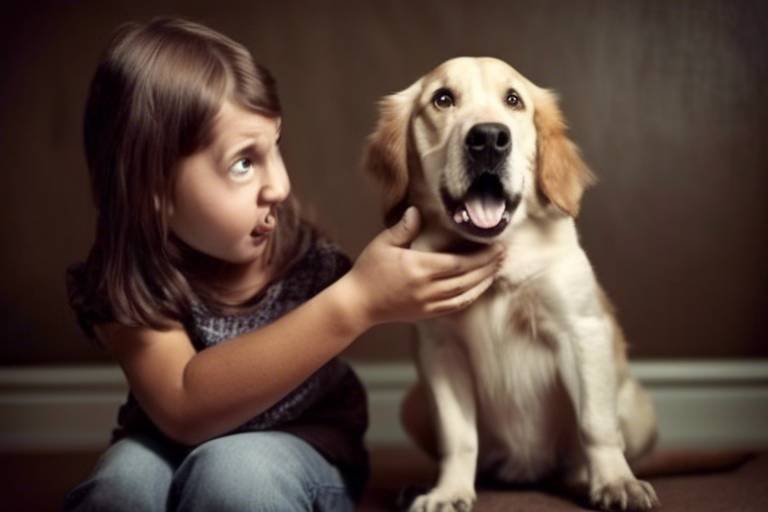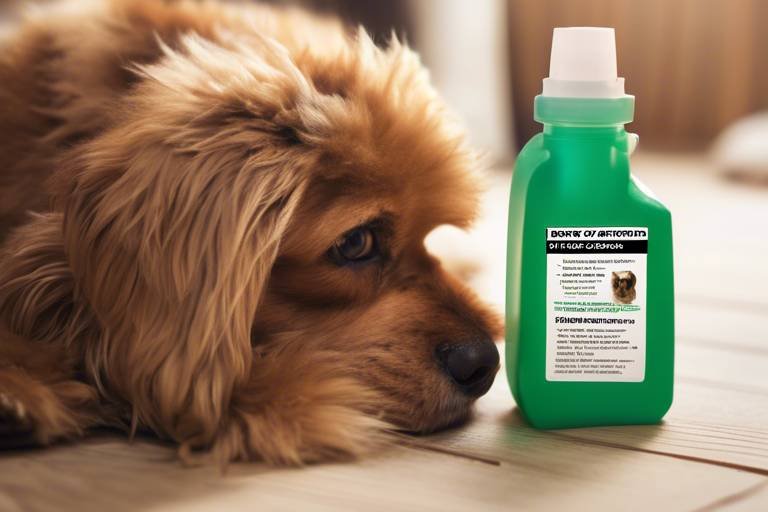How to Handle a Pet Emergency in Public
This article provides essential guidance on managing pet emergencies while in public spaces, ensuring the safety and well-being of your furry companions and those around you. Picture this: you're out for a lovely stroll in the park, enjoying the sun with your four-legged friend, when suddenly, something goes awry. Your heart races as you realize your pet is in distress. What do you do? Panic can set in, but knowing how to handle the situation can make all the difference. This guide is here to equip you with the knowledge and confidence to tackle any pet emergency you might face while out and about.
Understanding the symptoms of a pet emergency is crucial. Just like humans, pets can’t always communicate their discomfort or pain, so it’s vital to be vigilant. Common signs to look for include excessive barking, limping, vomiting, or unusual lethargy. If your pet is suddenly hiding or acting unusually aggressive, these could also be indicators of distress. Differentiating between minor issues and serious health concerns can be tricky, but paying attention to your pet’s behavior and physical condition is key. Remember, if something feels off, it’s better to err on the side of caution.
When a pet emergency occurs, quick action is vital. First, take a deep breath. Your pet can sense your anxiety, and staying calm will help you think clearly. Begin by assessing the situation. Is your pet conscious and responsive? Are there visible injuries? Gathering this information will help you determine the next steps. If it appears your pet is injured, check for any visible wounds or broken bones. If your pet is unconscious or having difficulty breathing, you may need to perform basic first aid while waiting for professional help.
Evaluating the severity of the emergency is essential. Start by checking your pet’s vital signs, such as heart rate and breathing. You can do this by placing your hand on their chest. A normal heart rate for dogs ranges from 60 to 100 beats per minute, while cats typically range from 140 to 220. If your pet's heart rate is significantly outside of these ranges, it’s time to seek help. Additionally, look for signs of shock, such as pale gums, rapid breathing, or weakness. Knowing how to assess your pet’s condition can guide your response effectively.
Learn how to conduct a quick physical examination of your pet to identify any visible injuries that may require immediate attention. Start at the head and work your way down to the tail. Check for swelling, cuts, or abrasions. Don’t forget to look in their mouth for any foreign objects or injuries. If your pet allows it, gently palpate their body to feel for any unusual lumps or areas of pain. This quick assessment can give you critical information to relay to a veterinarian.
In emergencies, maintaining composure is crucial. Panic can cloud your judgment, making it harder to think clearly. One effective technique is to take slow, deep breaths. These breaths can help lower your heart rate and clear your mind. Remember, your pet relies on you for guidance and support. If you find yourself overwhelmed, it’s okay to ask for help from bystanders. People are often willing to lend a hand, whether it’s holding your pet or calling for assistance.
Knowing where to seek help is important during a pet emergency. Look for nearby veterinary clinics, animal hospitals, or even pet-friendly stores that might have staff trained to assist in emergencies. Many parks and public spaces have first aid stations, so don’t hesitate to ask for help. If you have your smartphone handy, use it to search for the nearest veterinary services. In today’s world, information is just a click away, so take advantage of technology to find the help you need.
If transportation to a veterinary facility is necessary, it’s important to do so safely. You don’t want to exacerbate any injuries your pet may have. If your pet is small enough, using a pet carrier can provide a safe way to transport them. Ensure the carrier is well-ventilated and secure, so your pet feels safe during the journey. If your pet is larger and needs to be carried, make sure to support their body properly to avoid causing further injury.
A pet carrier can provide a safe way to transport your pet. Here, we discuss how to use a carrier effectively during an emergency. Make sure the carrier is sturdy and your pet is comfortable inside. You can encourage your pet to enter the carrier by using treats or their favorite toy. Once secured, keep the carrier stable during transportation to avoid jostling. If your pet is anxious, cover the carrier with a light blanket to help calm them down.
In certain situations, carrying your pet may be the best option. When carrying your pet, always support their body properly. For small dogs or cats, hold them close to your chest, ensuring their legs are secure. For larger breeds, it’s best to use a sling or blanket to help support their weight. Be mindful of their comfort, as carrying them improperly can cause more harm than good. Always keep an eye on your pet’s condition during transport.
Preparation can significantly reduce the impact of future emergencies. Regular vet check-ups, vaccinations, and keeping your pet's medical records handy can make a world of difference. Additionally, consider pet first aid classes. These classes can equip you with the skills to handle emergencies effectively. Always carry a pet first aid kit with essentials like bandages, antiseptic wipes, and any medication your pet may need. Being proactive can ensure your furry friend stays safe and healthy, even in unexpected situations.
- What should I do if my pet is injured in public?
Stay calm, assess the situation, and check for injuries. If necessary, transport your pet to the nearest veterinary clinic.
- How can I prepare for a pet emergency?
Regular vet visits, keeping a pet first aid kit, and knowing the locations of nearby veterinary services can help you be prepared.
- Is it safe to carry my pet during an emergency?
Yes, but make sure to support their body properly to avoid causing further injury.

Recognizing the Signs of a Pet Emergency
This article provides essential guidance on managing pet emergencies while in public spaces, ensuring the safety and well-being of your furry companions and those around you.
Understanding the symptoms of a pet emergency is crucial for every pet owner. Just like humans, pets can experience a range of health issues that require immediate attention. So, how can you tell if your furry friend is in trouble? It’s all about being observant and recognizing the signs. Some common symptoms that might indicate a pet emergency include:
- Excessive Vomiting or Diarrhea: If your pet is throwing up or has diarrhea multiple times in a row, it could be a sign of something more serious.
- Difficulty Breathing: Labored breathing or wheezing can indicate respiratory distress, which requires immediate intervention.
- Severe Lethargy: If your pet is unusually tired, not eating, or is difficult to wake, it might be a cause for concern.
- Visible Injuries: Cuts, bruises, or any signs of trauma should never be ignored. A quick examination can help identify the severity.
- Seizures: If your pet has a seizure, it’s critical to seek veterinary assistance right away.
But wait, there’s more! Sometimes, the signs can be less obvious. For instance, if your pet is suddenly acting out of character—like hiding, whining, or showing aggression—these can be subtle indicators of pain or distress. Think of it as your pet's way of saying, “I need help!”
Furthermore, it’s essential to differentiate between minor issues and serious health concerns. For example, while a little bit of drooling might not raise alarm bells, excessive drooling combined with other symptoms could point to poisoning or an allergic reaction. Always trust your instincts; if something feels off, it’s better to err on the side of caution.
In public spaces, where distractions abound, it can be easy to overlook these signs. However, being proactive and attentive can make all the difference. So, keep an eye out for your pet’s usual behavior and be ready to act if you notice anything unusual. Remember, your pet relies on you to be their advocate, especially in times of crisis. By recognizing the signs early, you can ensure a quicker response and potentially save your pet’s life.
When a pet emergency occurs, quick action is vital. Here, we outline the first steps to take to stabilize your pet and prepare for further assistance.
Evaluating the severity of the emergency is essential. This subheading details how to assess your pet's condition and determine the appropriate response.
Learn how to conduct a quick physical examination of your pet to identify any visible injuries that may require immediate attention.
In emergencies, maintaining composure is crucial. This section provides tips on how to stay calm while managing the situation effectively.
Knowing where to seek help is important during a pet emergency. This subheading discusses options for finding veterinary assistance in public settings.
If transportation to a veterinary facility is necessary, it’s important to do so safely. This section covers methods to transport your pet without causing further harm.
A pet carrier can provide a safe way to transport your pet. Here, we discuss how to use a carrier effectively during an emergency.
In certain situations, carrying your pet may be the best option. This subheading offers tips on how to safely carry different types of pets.
Preparation can significantly reduce the impact of future emergencies. This section outlines preventive steps to take for the well-being of your pet in public spaces.
Here are some common questions pet owners have regarding pet emergencies:
- What should I do if my pet is choking? If you suspect your pet is choking, try to remain calm. You can perform the Heimlich maneuver for pets or take them to the nearest vet.
- How do I know if my pet needs to see a vet immediately? If your pet shows any severe symptoms like difficulty breathing, seizures, or excessive bleeding, you should seek veterinary care immediately.
- Can I treat my pet at home for minor issues? While some minor issues can be treated at home, it’s always best to consult with a veterinarian for advice.

Immediate Steps to Take
When a pet emergency strikes, every second counts. It's like being in a high-stakes game where your furry friend’s health hangs in the balance. The first thing you need to do is stay calm. Panic can cloud your judgment and make it harder to act effectively. Take a deep breath and focus on what needs to be done. Remember, your pet can sense your anxiety, and a calm demeanor can help soothe them in this stressful situation.
Next, you should assess the situation quickly. Is your pet conscious? Are they breathing? Look for any visible signs of distress such as excessive panting, whining, or lethargy. Understanding the gravity of the situation can help you decide if you need to rush to the vet or if you can handle the issue with basic first aid. If you notice anything alarming, don’t hesitate to seek professional help.
Once you’ve evaluated your pet's condition, it’s time to take immediate action. Here’s a quick checklist to guide you:
- Check for any visible injuries: Look for cuts, bruises, or swelling.
- Control bleeding: If there’s bleeding, apply pressure with a clean cloth or bandage.
- Keep your pet warm: If they’re in shock, cover them with a blanket to maintain their body temperature.
- Don’t feed them: Avoid giving your pet food or water until a vet has assessed their condition.
After taking these steps, you should find help. If you’re in a public place, look for nearby veterinary clinics or animal hospitals. Many areas have emergency veterinary services that can provide immediate assistance. Don’t hesitate to ask bystanders for help; you’d be surprised how many fellow pet lovers are willing to lend a hand in a crisis.
In some cases, your pet may need to be transported to a veterinary clinic. If this is the case, ensure they are secure and comfortable during the journey. Use a pet carrier if possible, as this can prevent further injury and keep them safe. If your pet is too large for a carrier, consider using a blanket to support them while you carry them. Make sure to move quickly but gently, as sudden movements can exacerbate their condition.
Lastly, remember that staying focused is key. It’s easy to get overwhelmed in the heat of the moment, but try to keep your mind on the task at hand. By following these immediate steps, you’ll not only help your pet but also demonstrate your love and commitment to their well-being.
Q: What should I do if my pet is unresponsive?
A: If your pet is unresponsive, check for breathing and a heartbeat. If neither is present, perform CPR and seek immediate veterinary assistance.
Q: How can I prevent pet emergencies in public?
A: Regular vet check-ups, keeping your pet on a leash, and being aware of your surroundings can help prevent emergencies.
Q: Is it safe to give my pet first aid?
A: Basic first aid can be safe if you know what you’re doing. However, always consult a veterinarian for serious injuries or if you're unsure.
Assessing the Situation
When a pet emergency strikes, the first thing you need to do is to take a deep breath and assess the situation. Panic can cloud your judgment, and your furry friend needs you to be their rock in this stressful moment. Start by observing your pet closely. Are they behaving unusually? Are they showing signs of distress or pain? Look for any visible symptoms that might indicate the severity of the situation. For instance, do they have difficulty breathing, excessive bleeding, or signs of shock? These signs can help you gauge whether you’re dealing with a minor issue or something that requires immediate attention.
Next, consider the environment around you. Is it crowded? Are there any potential hazards nearby? Understanding your surroundings can be just as important as understanding your pet's condition. If you’re in a park, for example, is there a vet clinic nearby? Knowing where to go for help can save precious time. You might want to ask bystanders if they have any experience with pet emergencies. Sometimes, a little help from fellow pet lovers can make a world of difference.
Also, don’t forget to check for any potential hazards that might have caused the emergency. Did your pet ingest something they shouldn’t have? Are there sharp objects around? Identifying these factors can help you prevent further injury and provide critical information to the veterinarian later.
As you assess your pet’s condition, it may be helpful to create a mental checklist of the signs and symptoms you observe. This can include:
- Breathing difficulties
- Visible wounds or bleeding
- Unresponsiveness or lethargy
- Vomiting or diarrhea
- Signs of pain, such as whimpering or hiding
Remember, the goal is to quickly determine the best course of action. If your pet is conscious and responsive, gently assess their injuries without causing further pain. However, if they are unresponsive, you may need to act swiftly to get them the help they need. In such cases, time is of the essence, and your ability to remain calm while making these observations can be the difference between a successful outcome and a tragic one.
Ultimately, assessing the situation is about being observant and methodical. You’re not just a pet owner; you’re your pet’s guardian. Trust your instincts, and don’t hesitate to seek help if you feel overwhelmed. Your furry companion is counting on you!
Checking for Injuries
When your furry friend is in distress, the first thing you need to do is to conduct a thorough examination to check for injuries. Think of it as a quick health check-up that can make all the difference between a minor scare and a serious situation. Start by ensuring that the environment around you is safe. If your pet is in a public place, it’s important to keep them calm and secure while you assess their condition.
Begin your assessment by looking for visible signs of injury. These can include:
- Bleeding: Check for any wounds or cuts that may be bleeding. Even a small cut can be a cause for concern if it’s bleeding profusely.
- Swelling: Look for any areas of swelling, which may indicate a fracture or sprain.
- Abnormal Posture: Is your pet holding a leg up or favoring one side? This could signal pain or injury.
- Difficulty Breathing: If your pet is struggling to breathe, this is a serious issue that requires immediate attention.
As you conduct your examination, be gentle but thorough. If your pet is in pain, they may react defensively. Speak to them in a soothing voice to help keep them calm. If you notice any of the above signs, it’s crucial to take immediate action. You might also want to check their body temperature; a normal temperature for pets typically ranges from 100.5°F to 102.5°F. If it’s outside this range, it could indicate a problem.
After identifying potential injuries, it’s essential to determine whether your pet can stand or walk. If they can’t, it’s best to avoid moving them unless absolutely necessary, as this could worsen any injuries. Instead, focus on keeping them comfortable and calm until help arrives or you can transport them safely. Remember, your composure will help your pet feel more secure in a stressful situation.
In summary, checking for injuries involves a careful and calm approach. By being observant and gentle, you can quickly assess your pet's condition and take the necessary steps to ensure their safety and well-being.
Staying Calm and Focused
When a pet emergency strikes, it can feel like the world is falling apart. Your heart races, your palms sweat, and all you can think about is your furry friend in distress. But here's the kicker: staying calm and focused is crucial for both you and your pet. Think of it like being the captain of a ship during a storm; if you panic, the ship may capsize. Instead, take a deep breath and remember that your pet is looking to you for guidance and stability.
First things first, take a moment to breathe. Inhale deeply through your nose, hold for a couple of seconds, and exhale slowly through your mouth. This simple act can help clear your mind and allow you to think more clearly. When you're calm, you're better equipped to assess the situation and make informed decisions. A clear head can mean the difference between a hasty, potentially harmful action and a well-thought-out response.
Now, let’s talk about the power of visualization. Picture yourself successfully handling the emergency. Imagine yourself calmly assessing your pet's condition, calling for help, and transporting them safely. Visualization can be a powerful tool to reduce anxiety and boost your confidence. It’s like rehearsing for a play; the more you practice, the better you perform. So, when the moment arrives, you’ll be ready to take action.
Another tip to keep in mind is to communicate clearly. If you’re in a public space, don’t hesitate to ask for help. People are often willing to lend a hand, especially when they see someone in distress. Use clear and concise language when explaining the situation. For instance, instead of saying, "My dog is hurt," try, "My dog has a severe cut on its leg; can someone help me find a vet?" This not only conveys urgency but also helps others understand how they can assist you.
Lastly, remember that emotions can be contagious. If you’re panicking, your pet may pick up on that energy and become more anxious. Maintain a soothing tone when speaking to your pet, and use gentle, reassuring words. Think of it as creating a safe space amidst chaos. By staying calm, you’re not only helping yourself but also providing comfort to your beloved companion.
To sum it all up, staying calm and focused during a pet emergency is about preparation, breathing, visualization, clear communication, and emotional control. The next time you find yourself in a stressful situation with your pet, remember these strategies. They can help you navigate the storm and ensure that both you and your furry friend come out on the other side safe and sound.
- What should I do if my pet is injured in public? Assess the injury, stay calm, and seek help immediately.
- How can I keep my pet calm during an emergency? Use a soothing voice, gentle touch, and maintain a calm demeanor yourself.
- Is it okay to ask strangers for help? Absolutely! Many people are willing to assist in an emergency.
- What are the signs that my pet needs urgent care? Look for signs like excessive bleeding, difficulty breathing, or unresponsiveness.
Finding Help in Public
When a pet emergency strikes, knowing where to find help can be a game changer. Imagine this: your furry friend suddenly collapses at the park, and your heart races. Panic sets in, but you need to stay focused. First things first, look around. Are there any nearby veterinary clinics or animal hospitals? Many urban areas have veterinary services that cater to emergencies, and they often advertise their presence with clear signage. If you have a smartphone, quickly searching for “emergency vet near me” can provide immediate options.
Another great resource is the local animal control or humane society. They can often assist in emergencies or direct you to the nearest veterinary facility. Don’t hesitate to ask bystanders for help either; you might find someone who knows the area well and can guide you to the nearest vet. Remember, in these stressful moments, you’re not alone.
In addition to local resources, consider having a list of emergency contacts saved in your phone. This list can include:
- Your regular veterinarian's contact information
- Emergency veterinary clinics
- Animal control services
- Local pet hospitals
Having this information at your fingertips can save precious time when every second counts. Also, consider joining local pet owner groups on social media. These communities can be incredibly helpful, offering recommendations for emergency services and sharing experiences that can guide you in critical situations.
Lastly, be aware of your surroundings. If you’re in a public place like a park, there might be a pet-friendly business nearby, such as a pet store or a café that allows pets. Many of these places have connections with local veterinarians or can provide you with immediate assistance or advice. In public spaces, never underestimate the power of community; fellow pet owners are often more than willing to lend a hand.
In conclusion, finding help during a pet emergency in public can be daunting, but being prepared and knowing where to look can make all the difference. Keep your cool, utilize your resources, and remember that your pet's safety is the top priority.

Transporting Your Pet Safely
When a pet emergency strikes, ensuring your furry friend is transported safely to a veterinary facility is of utmost importance. The way you handle this situation can make a significant difference in your pet's well-being. Think of it as creating a safe bridge between your pet and the help they need. Here are some essential tips to keep in mind while transporting your pet.
First and foremost, the use of a pet carrier is highly recommended. A carrier not only keeps your pet secure but also minimizes the risk of further injury. If your pet is small enough, placing them in a well-ventilated carrier can provide a sense of security during a stressful time. Before placing your pet inside, ensure that the carrier is clean and free from any sharp objects that could cause harm. It's also a good idea to line the bottom with a soft blanket or towel to make it more comfortable for your pet.
In situations where a carrier isn't an option, you may need to carry your pet yourself. This can be tricky, especially with larger animals, but it’s essential to do it correctly to avoid causing additional stress or injury. For smaller pets, cradling them in your arms while supporting their back and legs can be effective. If you're dealing with a larger dog, consider using a blanket or a sturdy piece of fabric to create a makeshift sling. This method allows you to lift and carry them without putting too much strain on their body.
It's also crucial to remember the importance of staying calm during transportation. Pets can sense their owner's anxiety, which may exacerbate their own stress. Take a deep breath and try to speak to your pet in a soothing voice. Reassuring them can help keep them calm and make the journey smoother. If possible, have someone accompany you to help manage your pet during the transportation process, especially if they are large or particularly anxious.
Lastly, consider the environment during transport. If you're in a car, ensure that your pet is secured in a way that prevents them from moving around too much. Sudden stops or sharp turns can be dangerous for both you and your pet. If you’re using a vehicle, make sure the windows are closed enough to prevent them from jumping out, but open enough to allow fresh air to circulate. If you’re on foot, be mindful of your surroundings and avoid crowded areas where your pet may become overwhelmed.
In summary, transporting your pet safely during an emergency involves a combination of using the right equipment, staying calm, and being aware of your environment. By taking these steps, you can ensure that your pet receives the care they need without unnecessary stress or harm.
- What should I do if my pet is injured and I can't find a carrier? If a carrier is unavailable, use a blanket or towel to create a sling. This can help you support your pet while minimizing movement.
- How can I keep my pet calm during transportation? Speak softly to your pet and use familiar items like their favorite blanket or toy to provide comfort during the journey.
- Is it safe to transport my pet in the back of a pickup truck? No, it is not safe. Always use a secure carrier or harness to prevent your pet from falling out or getting injured.
Using a Pet Carrier
When it comes to handling a pet emergency in public, one of the most effective tools at your disposal is a pet carrier. This handy device can serve multiple purposes, not only providing a safe haven for your furry friend but also ensuring that you can transport them without causing additional stress or injury. Imagine trying to carry a frightened dog or a squirming cat; it can be quite a challenge! A pet carrier simplifies this process, making it easier for both you and your pet.
First and foremost, it's important to choose a carrier that is appropriate for your pet's size and weight. A carrier that is too small can cause discomfort, while one that is too large may not provide the sense of security your pet needs during a stressful time. Ideally, your pet should be able to stand, turn around, and lie down comfortably within the carrier. If you're unsure about the right size, many pet stores offer guidelines based on weight and breed, which can be incredibly helpful.
Once you have the right carrier, familiarize your pet with it ahead of time. This can make a world of difference in an emergency situation. You can do this by allowing your pet to explore the carrier at their own pace, placing their favorite blanket or toy inside, and rewarding them with treats for entering. A little preparation can transform the carrier from a foreign object into a cozy retreat, making it much easier to use in a crisis.
In an emergency, the way you handle the carrier is just as important as the carrier itself. Here are a few tips to keep in mind:
- Secure the carrier: Make sure the door is properly latched before moving. You don’t want your pet to escape at a critical moment!
- Keep it stable: When carrying the carrier, hold it securely and keep it level. Sudden jolts or tilting can frighten your pet.
- Stay calm: Your demeanor can affect your pet's behavior. If you remain calm and reassuring, your pet is more likely to feel secure.
In addition to these tips, consider the environment around you. If you're in a crowded area, try to find a quieter spot where you can assess your pet's condition without added distractions. This will help both you and your pet to focus on the situation at hand.
Finally, always have your pet's carrier easily accessible. Whether you're heading out for a walk or a trip to the park, having the carrier on hand can save precious time in an emergency. Think of it as your pet's safety net—an essential item that can make all the difference when you need it most.
Q: What type of pet carrier is best for my dog?
A: The best carrier for your dog depends on their size, breed, and temperament. Soft-sided carriers are great for calm pets, while hard-sided carriers offer more security for anxious dogs.
Q: How can I get my cat used to a carrier?
A: Start by placing the carrier in a familiar area and encouraging your cat to explore it. Use treats and toys to create positive associations.
Q: Is it safe to transport my pet in a carrier during an emergency?
A: Yes! A properly secured pet carrier is one of the safest ways to transport your pet during an emergency. It protects them from potential harm and keeps them contained.
Carrying Your Pet
When you find yourself in a situation where your furry friend needs to be moved quickly, knowing how to carry your pet safely can make all the difference. Whether your pet is a small dog or a cat, or even a larger breed, the method of carrying can vary significantly. It’s not just about getting them from point A to point B; it’s about ensuring their comfort and safety during the process. Imagine having to carry a squirming puppy or a frightened cat! It can be a daunting task, but with the right approach, you can make it manageable.
First and foremost, assess the size and condition of your pet. If they’re injured or in distress, approach them with caution. For smaller pets, like Chihuahuas or kittens, you can easily scoop them up with one hand under their chest and the other supporting their hindquarters. This method not only provides them with a sense of security but also prevents any further injury. For larger pets, like Golden Retrievers or bulldogs, you might need to use a technique that involves getting low to the ground to avoid straining your back. Bend at your knees, slide one arm under their belly, and use your other arm to support their back legs. This way, you can lift them securely without causing discomfort.
It’s also essential to keep your pet calm during the process. If your pet is panicking, they may struggle, which can lead to accidental injuries for both of you. Speak to them in a soothing voice, and if possible, use a calming product like a pheromone spray. You can also wrap them in a light blanket to provide a sense of security. This not only restricts their movement but also keeps them cozy, making them feel more at ease.
In cases where you need to carry your pet for an extended period, consider investing in a pet sling or a backpack carrier. These carriers are designed to distribute weight evenly, making it easier on your body while ensuring your pet is secure. They come in various sizes and styles, so you can choose one that fits your pet comfortably. Always check the carrier's weight limit and ensure that it’s suitable for your pet’s size.
Lastly, if you find yourself needing to carry a pet that is too large or heavy for you to handle alone, don't hesitate to ask for help. There’s no shame in seeking assistance, whether it’s from a friend nearby or a passerby who might be willing to lend a hand. Remember, your pet’s safety is the priority, and sometimes teamwork is the best way to ensure that happens!
- What should I do if my pet is too heavy for me to carry?
If your pet is too heavy, consider using a pet carrier or asking for help from someone nearby. It's essential to avoid straining yourself to prevent injury. - How can I keep my pet calm while carrying them?
Speak softly to your pet, use calming products, and consider wrapping them in a blanket to help them feel secure. - Is it safe to carry my pet in a backpack carrier?
Yes, as long as the carrier is designed for pets, fits your pet comfortably, and adheres to the weight limit.

Preventive Measures for Future Emergencies
When it comes to our furry companions, prevention is always better than cure. Taking proactive measures can significantly reduce the likelihood of a pet emergency occurring in the first place. So, how can you ensure your pet's safety while navigating public spaces? Here are some essential strategies to consider.
First and foremost, it's vital to have a well-fitted collar and an ID tag on your pet at all times. This simple step can make a world of difference if your pet gets lost or separated from you in a crowded area. The ID tag should include your phone number and, if possible, your address. Additionally, consider microchipping your pet as a more permanent form of identification. Microchips are small devices implanted under your pet's skin, and they can be scanned by veterinarians or animal shelters to retrieve your contact information.
Another critical preventive measure is to keep your pet up to date on vaccinations and regular health check-ups. This not only helps in preventing diseases but also ensures that any potential health issues are caught early. If your pet has specific health conditions, like allergies or heart problems, make sure to have a plan in place. For example, carry any necessary medications with you whenever you're out. Think of it as packing a first-aid kit, but tailored specifically for your pet's needs.
Moreover, familiarize yourself with basic first-aid techniques for pets. Knowing how to handle minor injuries or ailments can save precious time during an emergency. You can attend workshops or online courses specifically designed for pet first-aid. Here's a quick overview of some basic first-aid items you might consider carrying:
| First-Aid Item | Purpose |
|---|---|
| Gauze | For wrapping wounds or stopping bleeding |
| Antiseptic wipes | To clean wounds |
| Elastic bandage | For securing dressings |
| Pet thermometer | To check for fever |
| Emergency contact list | Including your vet and a nearby animal hospital |
Additionally, it's essential to observe your pet's behavior and body language. Animals can often sense changes in their environment, and they may react unpredictably in stressful situations. If you notice your pet becoming anxious or agitated, try to remove them from the source of stress. This could be a loud crowd, other aggressive animals, or even extreme weather conditions. Understanding your pet's triggers can help you prevent emergencies before they escalate.
Lastly, consider investing in training for your pet. A well-trained pet is less likely to get into trouble. Basic obedience training can teach your pet to respond to commands like "come" or "stay," which can be incredibly useful in potentially dangerous situations. Plus, it gives you peace of mind knowing that your pet can follow your instructions, even in chaotic environments.
By implementing these preventive measures, you can create a safer environment for your pet while enjoying your time in public spaces. Remember, a little preparation goes a long way in ensuring the well-being of your furry friend.
Q: What should I do if my pet gets lost in a public area?
A: Immediately search the area, calling your pet's name. Notify nearby people and businesses, and check with local shelters or animal control. If your pet has an ID tag or microchip, this will greatly increase the chances of being reunited.
Q: How often should I take my pet for a check-up?
A: It's generally recommended to take your pet for a check-up at least once a year. However, older pets or those with health issues may need more frequent visits.
Q: What are some signs that my pet is in distress?
A: Signs of distress can include excessive barking, whining, hiding, aggression, or changes in eating and sleeping habits. If you notice any unusual behavior, consult your veterinarian.
Frequently Asked Questions
- What should I do if I suspect my pet is having a medical emergency?
If you suspect your pet is experiencing a medical emergency, the first step is to stay calm and assess the situation. Look for signs such as difficulty breathing, excessive bleeding, or unresponsiveness. If any of these symptoms are present, it’s crucial to seek veterinary assistance immediately.
- How can I tell if my pet's condition is serious?
Recognizing the seriousness of your pet's condition can be challenging. Look for symptoms like persistent vomiting, seizures, or signs of pain (like whimpering or hiding). If you're uncertain, it's always safer to err on the side of caution and consult a vet.
- What are the best ways to transport my pet in an emergency?
In an emergency, transporting your pet safely is paramount. Use a sturdy pet carrier if possible, as it provides security and minimizes stress for your pet. If your pet is too large for a carrier, carefully carry them using a secure hold, ensuring their comfort and safety during the transport.
- How can I stay calm during a pet emergency?
Staying calm during a pet emergency can be tough, but it’s essential. Take deep breaths, focus on the steps you need to take, and remember that your pet can sense your emotions. Keeping a level head will help you make better decisions and reassure your furry friend.
- Where can I find veterinary help in public?
In public spaces, look for nearby veterinary clinics or animal hospitals. Many parks and public areas have signs with contact information for local vets. Additionally, using your smartphone to search for "emergency vet near me" can provide quick results.
- What preventive measures can I take to avoid pet emergencies?
Preventive measures include regular vet check-ups, keeping your pet's vaccinations up to date, and being aware of potential hazards in public spaces. Training your pet and having a first aid kit on hand can also prepare you for unexpected situations.



















